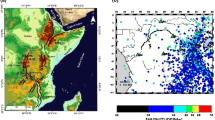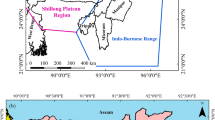Abstract
We developed a local magnitude scale for the Northern Punjab (Potwar Plateau and Salt Range), using seismic data of CES (Centre for Earthquake Studies). The region is tectonically stable, but surrounded by active geological structures (i.e., Main Boundary Thrust, Sulaiman Range, and Jhelum Fault). The imparted stresses adjust both seismically (moderate to small magnitude earthquakes) and aseismically in decollement. Previously, Southern California magnitude scale was being used to determine local magnitude for compilation of seismic catalog. Difference in geology and tectonics between Southern California and Northern Punjab may lead to systematic errors in hazard assessment based on this catalog. To address this problem, we selected 231 seismic events for a period of 07 years with ML 2.0 and above, that correspond to 2800 records on 21 seismic stations. We chose data of seismic events with hypocentral distance less than 600 km and recorded on five stations at least. We then inverted the synthetic Wood-Anderson amplitudes of selected data for station and distance corrections. Accordingly, the new magnitude scale for Northern Punjab is given by the following: ML = logA + 0.869log(r) + 0.00115(r) − 1.53, where A is the amplitude in nanometers on synthetic Wood-Anderson seismograph and r is the hypocentral distance in kilometers. We observed lower attenuation of seismic waves in our study area as compared to Southern California. Lower standard deviation (i.e., reduction in variance to 45.4% ) in magnitude residuals shows that there is less deviation for newly developed scale as compared to that of Southern California scale. Values of station correction factors for different stations of local network vary between − 0.5 to + 0.5, which suggest variation in station site effects.












Similar content being viewed by others
References
Alsaker A, Kvamme L, Hansen R, Dahle A, Bungum H (1991) The M L scale in Norway. Bull Seismol Soc Am 81(2):379–398
Argand E (1922) La tectonique de l’Asie. Conférence faite á Bruxelles, le 10 août 1922. In: Rep. Sess.-Int. Geol. Congr. 13, pp 170-372
Bakun WH (1984) Seismic moments, local magnitudes, and coda-duration magnitudes for earthquakes in central California. Bull Seismol Soc Am 74(2):439–458
Bakun WH, Joyner WB (1984) The M L scale in central California. Bull Seismol Soc Am 74(5):1827–1843
Banerjee P, Bürgmann R (2002) Convergence across the northwest Himalaya from GPS measurements. Geophys Res Lett 29(13):301–304
Banks C, Warburton J (1986) ‘Passive-roof’ duplex geometry in the frontal structures of the Kirthar and Sulaiman mountain belts, Pakistan. J Struct Geol 8(3-4):229–237
Bendick R, McClusky S, Bilham R, Asfaw L, Klemperer S (2006) Distributed Nubia—Somalia relative motion and dike intrusion in the Main Ethiopian Rift. Geophys J Int 165(1):303–310
Bernard M, Shen-Tu B, Holt W, Davis D (2000) Kinematics of active deformation in the Sulaiman Lobe and Range, Pakistan. J Geophys Res: Solid Earth 105(B6):13,253–13,279
Bilham R (2006) Dangerous tectonics, fragile buildings, and tough decisions. Science 311 (5769):1873–1875
Bindi D, Spallarossa D, Eva C, Cattaneo M (2005) Local and duration magnitudes in northwestern Italy, and seismic moment versus magnitude relationships. Bull Seismol Soc Am 95(2):592–604
Blisniuk PM, Sonder LJ, Lillie RJ (1998) Foreland normal fault control on northwest Himalayan thrust front development. Tectonics 17(5):766–779
Bobbio A, Vassallo M, Festa G (2009) A local magnitude scale for Southern Italy. Bull Seismol Soc Am 99(4):2461–2470
Booth DC (2007) An improved UK local magnitude scale from analysis of shear and Lg-wave amplitudes. Geophys J Int 169(2):593–601
Bormann P, Baumbach M, Bock G, Grosser H, Choy GL, Boatwright J (2002) Seismic sources and source parameters. IASPEI New Manual of Seismological Observatory Practice 1:1–94
Bragato PL, Tento A (2005) Local magnitude in Northeastern Italy. Bull Seismol Soc Am 95 (2):579–591
Ebel JE (1982) ML Measurements for northeastern United States earthquakes. Bull Seismol Soc Am 72(4):1367–1378
Farah A, Mirza MA, Ahmad MA, Butt MH (1977) Gravity field of the buried shield in the Punjab Plain, Pakistan. Geol Soc Am Bull 88(8):1147–1155
Gansser A (1964) Geology of the Himalayas. Wiley Interscience, New York
Gansser A (1981) The geodynamic history of the Himalaya. Zagros Hindu Kush Himalaya Geodynamic Evolution, pp 111–121
Ghosh A, Newman AV, Thomas AM, Farmer GT (2008) Interface locking along the subduction megathrust from b-value mapping near Nicoya Peninsula, Costa Rica. Geophys Res Lett 35(1):L01301
Gutenberg Bu, Richter CF (1954) Seismicity of the earth and related phenomena. Princeton (NJ)
Hadley DM, Helmberger DV, Orcutt JA (1982) Peak acceleration scaling studies. Bull Seismol Soc Am 72(3):959– 979
Haines AJ (1981) A local magnitude scale for New Zealand earthquakes. Bull Seismol Soc Am 71 (1):275–294
Hanks TC, Kanamori H (1979) A moment magnitude scale. J Geophys Res 84(B5):2348–2350
Havskov J, Ottemöller L (2010) Location. In: Routine data processing in earthquake seismology, Springer, pp 101–149
Hofstetter R, Beyth M (2003) The Afar Depression: interpretation of the 1960–2000 earthquakes. Geophys J Int 155(2):715–732
Hutton L, Boore DM (1987) The ML scale in Southern California. Bull Seismol Soc Am 77 (6):2074–2094
Jennings PC, Kanamori H (1983) Effect of distance on local magnitudes found from strong-motion records. Bull Seismol Soc Am 73(1):265–280
Kanamori H, Anderson DL (1975) Theoretical basis of some empirical relations in seismology. Bull Seismol Soc Am 65(5):1073–1095
Kazmi AH, Rana RA (1982) Tectonic map of Pakistan, 1:2,000,000. Geological Survey of Pakistan, Quetta
Keir D, Stuart G, Jackson A, Ayele A (2006) Local earthquake magnitude scale and seismicity rate for the Ethiopian rift. Bull Seismol Soc Am 96(6):2221–2230
Kılıç T, Ottemöller L, Havskov J, Yanık K, Kılıçarslan Ö, Alver F, Özyazıcıoğlu M (2017) Local magnitude scale for earthquakes in Turkey. J Seismol 21(1):35–46
Kim WY (1998) The ML scale in eastern North America. Bull Seismol Soc Am 88(4):935–951
Kiratzi A, Papazachos B (1984) Magnitude scales for earthquakes in Greece. Bull Seismol Soc Am 74(3):969–985
Langston CA, Brazier R, Nyblade AA, Owens TJ (1998) Local magnitude scale and seismicity rate for Tanzania, East Africa. Bull Seismol Soc Am 88(3):712–721
Minster JB, Jordan TH (1978) Present-day plate motions. J Geophys Res 83(B11):5331–5354
Mogi K (1962) Study of elastic shocks caused by the fracture of heterogeneous materials and its relation to earthquake phenomena. Bull Earthq Res Inst Univ Tokyo 40:125– 173
Molnar P (1984) Structure and tectonics of the Himalaya: constraints and implications of geophysical data. Annu Rev Earth Planet Sci 12(1):489–516
Nguyen LM, Lin TL, Wu YM, Huang BS, Chang CH, Huang WG, Le TS, Dinh VT (2011) The first ML scale for North of Vietnam. J Asian Earth Sci 40(1):279–286
Powell CM, Conaghan P (1973) Plate tectonics and the Himalayas. Earth Planet Sci Lett 20 (1):1–12
Pujol J (2003) Determination of a local magnitude scale: a generalized inverse solution. Bull Seismol Soc Am 93(6):2758–2761
Quittmeyer RC, Farah A, Jacob KH (1979) The seismicity of Pakistan and its relation to surface faults. Geodynamics of Pakistan, pp 271–284
Richter CF (1935) An instrumental earthquake magnitude scale. Bull Seismol Soc Am 25(1):1–32
Ristau J, Rogers GC, Cassidy JF (2005) Moment magnitude–local magnitude calibration for earthquakes in Western Canada. Bull Seismol Soc Am 95(5):1994–2000
Satyabala SP, Yang Z, Bilham R (2012) Stick–slip advance of the Kohat Plateau in Pakistan. Nat Geosci 5(2):147–150
Saunders I, Ottemöller L, Brandt MB, Fourie CJ (2013) Calibration of an m L scale for South Africa using tectonic earthquake data recorded by the South African National Seismograph Network: 2006 to 2009. J Seismol 17(2):437–451
Schelling D (1992) The tectonostratigraphy and structure of the eastern Nepal Himalaya. Tectonics 11(5):925–943
Scholz C (1968) The frequency-magnitude relation of microfracturing in rock and its relation to earthquakes. Bull Seismol Soc Am 58(1):399–415
Schorlemmer D, Wiemer S (2005) Earth science: microseismicity data forecast rupture area. Nature 434(7037):1086
Schorlemmer D, Wiemer S, Wyss M (2004) Earthquake statistics at Parkfield: 1. Stationarity of b values. J Geophys Res 109(B12)
Schorlemmer D, Wiemer S, Wyss M (2005) Variations in earthquake-size distribution across different stress regimes. Nature 437(7058):539–542
Seeber L, Armbruster J (1979) Seismicity of the Hazara arc in northern Pakistan: decollement vs. basement faulting. Geodynamics of Pakistan 131:142
Seeber L, Armbruster JG, Quittmeyer RC (1981) Seismicity and continental subduction in the Himalayan arc. Zagros Hindu Kush Himalaya Geodynamic Evolution, Geodyn Ser 3:215–242
Shoja-Taheri J, Naserieh S, Ghafoorian-Nasab AH (2008) An ML scale in northeastern Iran. Bull Seismol Soc Am 98(4):1975–1982
Slejko D, Rebez A (2002) Probabilistic seismic hazard assessment and deterministic ground shaking scenarios for Vittorio Veneto (NE Italy). Boll Geofis Teor Appl 43:263–280
Srivastava P, Mitra G (1994) Thrust geometries and deep structure of the outer and lesser Himalaya, Kumaon and Garhwal (India): Implications for evolution of the Himalayan fold-and-thrust belt. Tectonics 13(1):89–109
Takeo M, Abe K (1981) Local magnitude determination from near-field accelerograms. Zisin, J Seism Soc Jap 34:495–504
Treloar PJ, Coward MP, Harris NB (1992) Himalayan-tibetan analogies for the evolution of the Zimbabwe Craton and Limpopo Belt. Precambrian Res 55(1-4):571–587
Urbancic T, Trifu C, Long J, Young R (1992) Space-time correlations of b values with stress release. Pure Appl Geophys 139(3-4):449–462
Uski M, Tuppurainen A (1996) A new local magnitude scale for the Finnish seismic network. Tectonophysics 261(1-3):23–37
Warren NW, Latham GV (1970) An experimental study of thermally induced microfracturing and its relation to volcanic seismicity. J Geophys Res 75(23):4455–4464
Wiemer S, Wyss M (2002) Mapping spatial variability of the frequency-magnitude distribution of earthquakes. In: Advances in Geophysics, vol 45, Elsevier, pp 259–V
Wyss M (1973) Towards a physical understanding of the earthquake frequency distribution. Geophys J Int 31(4):341– 359
Wyss M, Sammis CG, Nadeau RM, Wiemer S (2004) Fractal dimension and b-value on creeping and locked patches of the San Andreas fault near Parkfield, California. Bull Seismol Soc Am 94 (2):410–421
Yeats RS, Khan SH, Akhtar M (1984) Late quaternary deformation of the Salt Range of Pakistan. Geol Soc Am Bull 95(8):958–966
Yin A, Harrison TM (2000) Geologic evolution of the Himalayan-Tibetan orogen. Annu Rev Earth Planet Sci 28(1):211–280
Acknowledgments
We received significant help from Mr. Muhammad Tahir Iqbal in improving geological content of area, Mr. Bilal Saif regarding Cartography and Mr. Saleem Iqbal for script writing.
Author information
Authors and Affiliations
Corresponding author
Additional information
Publisher’s note
Springer Nature remains neutral with regard to jurisdictional claims in published maps and institutional affiliations.
Appendix: Error in location
Appendix: Error in location
The appendix represents error in location (i.e., latitude and longitude). Seisan software has been used for earthquake location, with Hypo71 routine. We use the 2D velocity model that developed for Southern California. In location, if azimuthal coverage is poor, i.e., less than 100∘, then we additionally use seismic stations from other networks. In most of cases, stations of Pakistan Meteorological Department(PMD) are added, other than PMD stations, we also use data of USGS stations in certain cases for improvement in location. Error in latitude and longitude of seismic events used in this study are shown in Figs. 13 and 14. Average value of error in latitude and longitude for our network is 8 and 10 km respectively.
Rights and permissions
About this article
Cite this article
Mushtaq, M.N., Tahir, M., Shah, M.A. et al. Development of local magnitude scale for the Northern Punjab, Pakistan. J Seismol 23, 403–416 (2019). https://doi.org/10.1007/s10950-018-09813-y
Received:
Accepted:
Published:
Issue Date:
DOI: https://doi.org/10.1007/s10950-018-09813-y






